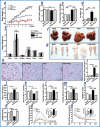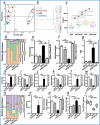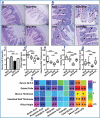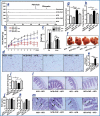Phlorizin ameliorates obesity-associated endotoxemia and insulin resistance in high-fat diet-fed mice by targeting the gut microbiota and intestinal barrier integrity
- PMID: 33222603
- PMCID: PMC7714487
- DOI: 10.1080/19490976.2020.1842990
Phlorizin ameliorates obesity-associated endotoxemia and insulin resistance in high-fat diet-fed mice by targeting the gut microbiota and intestinal barrier integrity
Abstract
Phlorizin (PHZ) is one of phytonutrients in apples that contributes to the health-promoting effect implicated by the saying, 'an apple a day keeps the doctor away'. PHZ was firstly identified as a competitive inhibitor of sodium-glucose co-transporters-2 (SGLT2); however, its low bioavailability makes it hard to fully explain its pharmacological mechanisms. This study aimed to investigate the ameliorating effect of PHZ on high-fat diet (HFD)-induced obesity via modulating the "gut microbiota-barrier axis". Firstly, C57BL/6 J mice were fed a normal chow diet (NCD) or HFD coadministered with or without PHZ for 12 weeks. Our results showed that PHZ supplementation significantly reduced HFD-induced body weight gain (P < .001), alleviated metabolic disorders (MDs) like insulin resistance (P < .001) and elevation of serum lipopolysaccharides (LPS) (P < .001), attenuated HFD-induced gut microbiota alterations, enhanced short-chain fatty acids (SCFAs) production (P < .001), and inhibited fecal LPS production (P < .001). To investigate the role of the fecal microbiota in the observed beneficial effects, a fecal microbiota transplantation (FMT) experiment was performed by transplanting the feces of the four groups of mice (as donor mice) daily collected from the fourth week to a new batch of acclimatized HFD-fed mice. Our results confirmed that feeding the gut contents of the PHZ-modulated mice could attenuate HFD-induced MDs, accompanied by enhanced glucagon-like peptide 2 (GLP-2) secretion (P < .001) and restoration of HFD-induced damage in the gut epithelial barrier. This study has provided evidence that the "gut microbiota-barrier axis" was an alternative target for the anti-obesity effect of PHZ. This work has also provided an explanation for the high efficacy of PHZ despite the low bioavailability, and PHZ holds great potential to be developed as a functional food ingredient.
Keywords: Phlorizin (PHZ); barrier integrity; glucagon-like peptide 2 (GLP-2); gut microbiota; obesity; short-chain fatty acids (SCFAs).
Figures






Similar articles
-
Maternal Phlorizin Intake Protects Offspring from Maternal Obesity-Induced Metabolic Disorders in Mice via Targeting Gut Microbiota to Activate the SCFA-GPR43 Pathway.J Agric Food Chem. 2024 Mar 6;72(9):4703-4725. doi: 10.1021/acs.jafc.3c06370. Epub 2024 Feb 13. J Agric Food Chem. 2024. PMID: 38349207
-
Apple-Derived Pectin Modulates Gut Microbiota, Improves Gut Barrier Function, and Attenuates Metabolic Endotoxemia in Rats with Diet-Induced Obesity.Nutrients. 2016 Feb 29;8(3):126. doi: 10.3390/nu8030126. Nutrients. 2016. PMID: 26938554 Free PMC article.
-
Purified Phlorizin from DocynIa Indica (Wall.) Decne by HSCCC, Compared with Whole Extract, Phlorizin and Non-Phlorizin Fragment Ameliorate Obesity, Insulin Resistance, and Improves Intestinal Barrier Function in High-Fat-Diet-Fed Mice.Molecules. 2018 Oct 19;23(10):2701. doi: 10.3390/molecules23102701. Molecules. 2018. PMID: 30347741 Free PMC article.
-
Synergistic Interplay of Diet, Gut Microbiota, and Insulin Resistance: Unraveling the Molecular Nexus.Mol Nutr Food Res. 2024 Dec;68(23):e2400677. doi: 10.1002/mnfr.202400677. Epub 2024 Nov 16. Mol Nutr Food Res. 2024. PMID: 39548908 Review.
-
Negative Effects of a High-Fat Diet on Intestinal Permeability: A Review.Adv Nutr. 2020 Jan 1;11(1):77-91. doi: 10.1093/advances/nmz061. Adv Nutr. 2020. PMID: 31268137 Free PMC article. Review.
Cited by
-
Yeast mannoproteins are expected to be a novel potential functional food for attenuation of obesity and modulation of gut microbiota.Front Nutr. 2022 Oct 14;9:1019344. doi: 10.3389/fnut.2022.1019344. eCollection 2022. Front Nutr. 2022. PMID: 36313084 Free PMC article.
-
Moutai Distiller's grains Polyphenol extracts and rutin alleviate DSS-induced colitis in mice: Modulation of gut microbiota and intestinal barrier function (R2).Heliyon. 2023 Nov 11;9(11):e22186. doi: 10.1016/j.heliyon.2023.e22186. eCollection 2023 Nov. Heliyon. 2023. PMID: 38045189 Free PMC article.
-
Gut Microbiota: An Important Player in Type 2 Diabetes Mellitus.Front Cell Infect Microbiol. 2022 Feb 15;12:834485. doi: 10.3389/fcimb.2022.834485. eCollection 2022. Front Cell Infect Microbiol. 2022. PMID: 35242721 Free PMC article. Review.
-
Role of Sodium-Glucose Co-Transporter 2 Inhibitors in the Regulation of Inflammatory Processes in Animal Models.Int J Mol Sci. 2022 May 18;23(10):5634. doi: 10.3390/ijms23105634. Int J Mol Sci. 2022. PMID: 35628443 Free PMC article. Review.
-
Diammonium Glycyrrhizinate Ameliorates Obesity Through Modulation of Gut Microbiota-Conjugated BAs-FXR Signaling.Front Pharmacol. 2021 Dec 21;12:796590. doi: 10.3389/fphar.2021.796590. eCollection 2021. Front Pharmacol. 2021. PMID: 34992541 Free PMC article.
References
-
- Petersen C. Analyse des phloridzins. Eur J Org Chem. 1835;15:1. doi:10.1002/jlac.18350150210. - DOI
Publication types
MeSH terms
Substances
LinkOut - more resources
Full Text Sources
Research Materials
Miscellaneous
